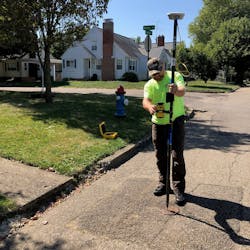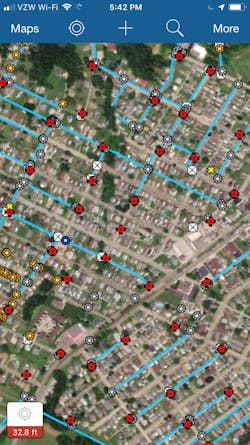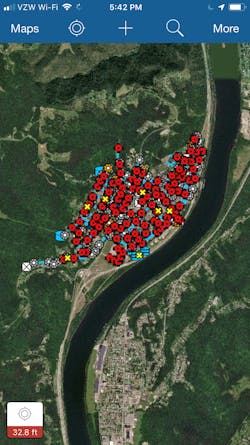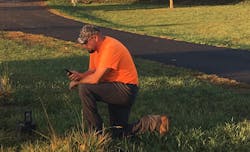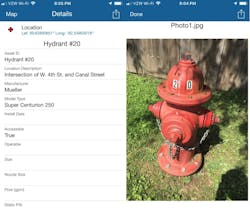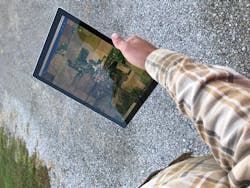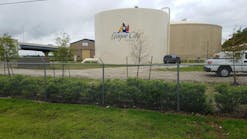Ohio Rural Water Association helps public water systems with compliance challenge
The Ohio Legislature passed Senate Bill 2 in October 2017. This bill required all public water systems to demonstrate technical, managerial, and financial capability through the implementation of an asset management program. In short, public water systems needed to show that they know what assets they have, where they are located, and how they are going to be maintained.
In anticipation of the bill, the Ohio Rural Water Association (ORWA) began considering how it could assist members in meeting the new regulatory requirements. It was clear that each member would need to create an asset management plan, so that’s where we started. We had heard about GIS and knew that it was a strong tool for supporting an asset management program. We reviewed several GIS options, some that were free and some that were not. The GIS needed to provide increased efficiencies, be affordable, be of good quality and be easy to use. ORWA members needed a tool that would support them now and into the future; which led to the decision of utilizing Esri’s ArcGIS.
The challenge was how to fund the program, and that is where the Ohio Water Development Authority (OWDA) became an essential partner. After writing and submitting a proposal to OWDA’s Board of Directors, OWDA determined ORWA’s approach to assisting Ohio’s Public Water systems with asset management fit right in line with their mission. They voted unanimously to provide the funds that we requested.
Although it’s not free, the big win with ArcGIS is the ability to use it in the cloud with applications to collect and update information from the field, with little training. What really helped us to decide was the ability to collect data and see it appear on a map instantaneously. There was no waiting for weeks or additional tasks required. Seeing your work, having the ability to edit data, and creating a map as you work helps members feel accomplished and encourages them to be successful. They know that they are contributing to the future prosperity of their system.
Neither ORWA nor I had never used ArcGIS. I contacted Esri about getting the software and was able to work with them to set up ArcGIS Pro and ArcGIS Online accounts. Our next challenge was getting members started and comfortable with the software. What would be the easiest way to support them?
I met with Esri to create an agreement that allowed ORWA to purchase the first year of ArcGIS Online for Ohio’s rural water systems. After the first year, members would decide whether to continue and take responsibility for the license or go another route. That was exactly what we needed!
The licensing agreement with Esri works well because it allows ORWA staff to support members by setting up a map, sharing an easy-to-use template, and training members to use Collector for ArcGIS, enabling data collection in the field. Each organization signs an asset management assistance agreement that certifies they are members and public water systems. The agreement specifies that they have a primary role in creating an asset management program for their system, and that ORWA can purchase the software on their behalf.
One of the biggest challenges for our members is changing how they work. Working with digital maps is different from using paper maps. With ArcGIS, they have to learn how to use smart devices to collect data and find information. They see that the benefits for their system’s future outweigh the growing pains of today. Staff are able to access information immediately, work more efficiently, and pass their knowledge on to future generations — and of course, meet the requirements of Senate Bill 2.
When ORWA began its Asset Management Program to support its members, Michael Copeland, Circuit Rider with ORWA, was very interested in being involved. He started by launching a pilot project to create a water distribution map of his neighborhood system. He expanded his ArcGIS knowledge quickly, with guidance from ORWA’s executive director as well as online resources. Copeland has become an expert at collecting data, syncing data from the field, and using Collector for ArcGIS. “[It]was very user friendly. I found it to be intuitive and easy to learn,” he said.
Each community Copeland works with is gaining intimate knowledge of their system: locating assets, identifying maintenance needs, and creating a view into their work that they didn’t have before.
Getting More Than a Map
The Village of Payne is roughly one square mile. The Water and Sewer Department serves 1,200 customers. Allen Wobler, water and sewer operator, had been maintaining these systems with paper maps that were 40-50 years old. Wobler needed to update his maps so he reached out to the ORWA.
ORWA sent Copeland to help Wobler learn to use ArcGIS Online and Collector for ArcGIS. Copeland and Wobler spent a day doing hands on training, collecting asset information and locations. At the end of the day, Wobler was able to use his Microsoft tablet to see what he had accomplished in a digital map. The digital map increased field efficiencies by 50 percent. It’s continually improving and it helps to get grants by being accurate and easy to reference.
“I’m not scratching my head looking for valves anymore. I know now the precise location of every aspect of my distribution system,” Wobler said. “I see what valves have been exercised. I’m aware of the status of work being done. We will never go back to paper. ArcGIS has enabled us to be compliant and to better manage our system.”
Collecting Data and Knowledge
The Village of Belle Center has an area of 0.71 square miles. When Brandon Bingham, water superintendent, started with the Village of Belle Center in 2017 everything was on paper. Sometimes the paper maps didn’t have accurate information.
Bingham knew that the ORWA was helping members to move into digital maps so he contacted them for help. Copeland spent three hours with Bingham, teaching him to collect data using his smartphone and Collector for ArcGIS. Bingham now has immediate access to a digital map, information about leaks, maintenance activities, and more.
“The work that has been done not only enables us to meet the Senate Bill requirements, it also supports our system management, allowing me to perform and track preventative maintenance and avoid emergency situations,” Bingham said. WW
Editor’s note: This article has been adapted and reproduced with permission from Esri.
